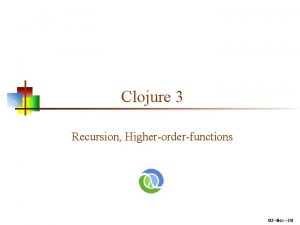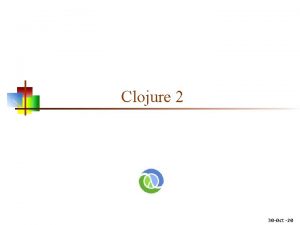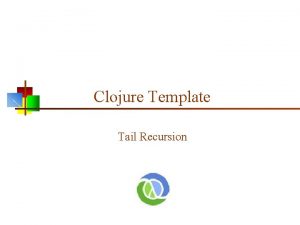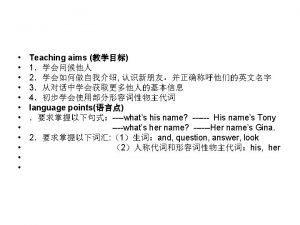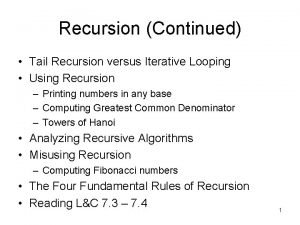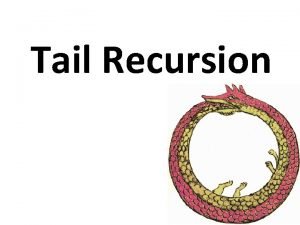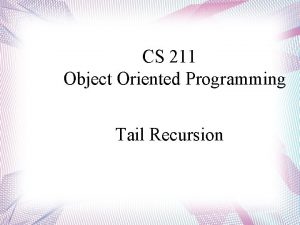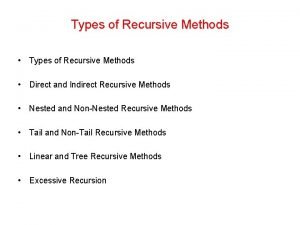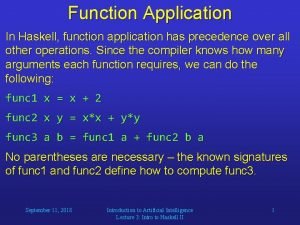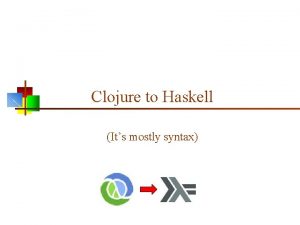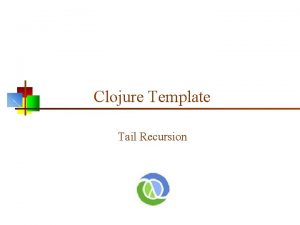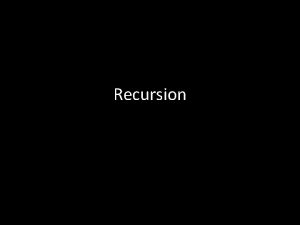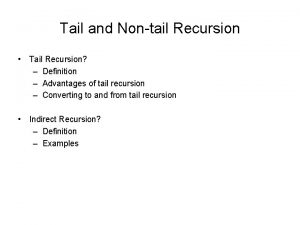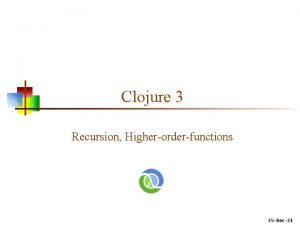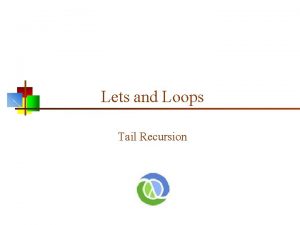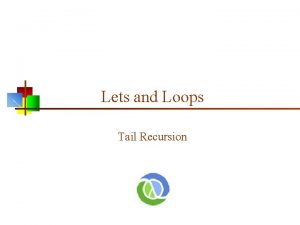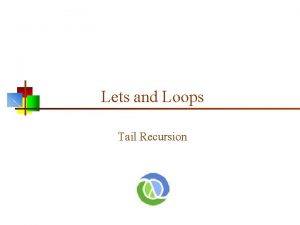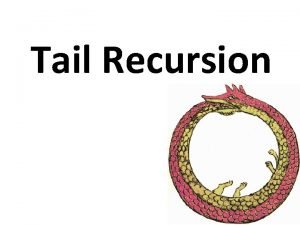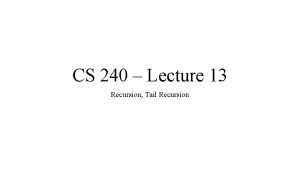Clojure Template Tail Recursion Hello Factorial n n



![Adding an accumulator n n (defn factorial-two-args [acc n] (if (zero? n) acc (recur Adding an accumulator n n (defn factorial-two-args [acc n] (if (zero? n) acc (recur](https://slidetodoc.com/presentation_image_h2/a4940b1d27747a457d6242e84ae19e39/image-4.jpg)


![When tail recursion isn’t n n The function (defn factorial-? [acc n] (if (zero? When tail recursion isn’t n n The function (defn factorial-? [acc n] (if (zero?](https://slidetodoc.com/presentation_image_h2/a4940b1d27747a457d6242e84ae19e39/image-7.jpg)

![Defining a local helper function n (defn factorial-4 [number] (let [factorial-helper (fn [acc n] Defining a local helper function n (defn factorial-4 [number] (let [factorial-helper (fn [acc n]](https://slidetodoc.com/presentation_image_h2/a4940b1d27747a457d6242e84ae19e39/image-9.jpg)

![let and loop comparison n n (defn factorial-4 [number] (let [factorial-helper (fn [acc n] let and loop comparison n n (defn factorial-4 [number] (let [factorial-helper (fn [acc n]](https://slidetodoc.com/presentation_image_h2/a4940b1d27747a457d6242e84ae19e39/image-11.jpg)
![shallow-reverse n n (defn shallow-reverse-1 ([lst] (shallow-reverse () lst)) ([acc lst] (if (empty? lst) shallow-reverse n n (defn shallow-reverse-1 ([lst] (shallow-reverse () lst)) ([acc lst] (if (empty? lst)](https://slidetodoc.com/presentation_image_h2/a4940b1d27747a457d6242e84ae19e39/image-12.jpg)

![Find the average of a sequence n n (defn avg [a-seq] (loop [sum 0, Find the average of a sequence n n (defn avg [a-seq] (loop [sum 0,](https://slidetodoc.com/presentation_image_h2/a4940b1d27747a457d6242e84ae19e39/image-14.jpg)


- Slides: 16

Clojure Template Tail Recursion

Hello, Factorial! n n The factorial function is everybody’s introduction to recursion (defn factorial-1 [n] (if (zero? n) 1 (* n (factorial-1 (dec n))))) (factorial-1 10) ; => 3628800 The problem with this function is that every recurrence increases the stack size n Not a problem if the number of recurrences is small 2

Tail recursion, or tail call recursion n A function is tail recursive if, for every recursive call in the function, the recursive call is the last thing done in the function n In this situation, the compiler can replace the recursion with a simple loop, which does not add frames to the stack The programmer still does not have (or need!) loops In factorial-1, (* n (factorial-1 (dec n))) the multiplication keeps it from being tail recursive n To make the factorial function tail recursive, we need to somehow bring the multiplication into the parameter list 3
![Adding an accumulator n n defn factorialtwoargs acc n if zero n acc recur Adding an accumulator n n (defn factorial-two-args [acc n] (if (zero? n) acc (recur](https://slidetodoc.com/presentation_image_h2/a4940b1d27747a457d6242e84ae19e39/image-4.jpg)
Adding an accumulator n n (defn factorial-two-args [acc n] (if (zero? n) acc (recur (* acc n) (dec n)))) One way to think of this is as “pumping” information from the input parameter to the accumulator 4

Using factorial-two-args n n n (factorial-helper 1 10) ; => 3628800 (factorial-helper 0 10) ; => 0 (factorial-helper 10 1) ; => 10 5

Use of a faҫade n n We can use a façade along with the “real” function (now called “factorial-helper” (defn factorial-2 [n] (factorial-helper 1 n)) (defn factorial-helper [acc n] (if (zero? n) acc (recur (* acc n) (dec n)))) n This adds an unnecessary function to those available to the user 6
![When tail recursion isnt n n The function defn factorial acc n if zero When tail recursion isn’t n n The function (defn factorial-? [acc n] (if (zero?](https://slidetodoc.com/presentation_image_h2/a4940b1d27747a457d6242e84ae19e39/image-7.jpg)
When tail recursion isn’t n n The function (defn factorial-? [acc n] (if (zero? n) acc (factorial-? (* acc n) (dec n)))) is tail recursive, but that doesn’t do you any good unless you tell the compiler to replace the recursion with a loop Use recur instead of factorial-? in the tail call 7

Polymorphic parameters n n Clojure functions can be defined with more than one parameter list (defn factorial-3 ([n] (factorial-3 1 n)) ([acc n] (if (zero? n) acc (recur (* acc n) (dec n)) ) 8
![Defining a local helper function n defn factorial4 number let factorialhelper fn acc n Defining a local helper function n (defn factorial-4 [number] (let [factorial-helper (fn [acc n]](https://slidetodoc.com/presentation_image_h2/a4940b1d27747a457d6242e84ae19e39/image-9.jpg)
Defining a local helper function n (defn factorial-4 [number] (let [factorial-helper (fn [acc n] (if (zero? n) acc (recur (* acc n) (dec n))))] (factorial-helper 1 number))) 9

let and loop n n n In the previous example, we used (let [factorial-helper (fn [acc n] …]…) to define a helper function with local scope The general form is (let [name 1 value 1, …, name. N value. N] code) and we use recur in the code to tell the compiler to turn this into a loop To simplify this, Clojure provides a loop construct: (loop [name 1 value 1, …, name. N value. N] code) n n n This is not a loop; it’s a request to the compiler to turn tail recursion into a loop! The name/value pairs are initial values of parameters The call to recur in the body supplies new values for the parameters 10
![let and loop comparison n n defn factorial4 number let factorialhelper fn acc n let and loop comparison n n (defn factorial-4 [number] (let [factorial-helper (fn [acc n]](https://slidetodoc.com/presentation_image_h2/a4940b1d27747a457d6242e84ae19e39/image-11.jpg)
let and loop comparison n n (defn factorial-4 [number] (let [factorial-helper (fn [acc n] (if (zero? n) acc (recur (* acc n) (dec n))))] (factorial-helper 1 number))) (defn factorial-5 [number] (loop [acc 1, n number] (if (zero? n) acc (recur (* acc n) (dec n))))) 11
![shallowreverse n n defn shallowreverse1 lst shallowreverse lst acc lst if empty lst shallow-reverse n n (defn shallow-reverse-1 ([lst] (shallow-reverse () lst)) ([acc lst] (if (empty? lst)](https://slidetodoc.com/presentation_image_h2/a4940b1d27747a457d6242e84ae19e39/image-12.jpg)
shallow-reverse n n (defn shallow-reverse-1 ([lst] (shallow-reverse () lst)) ([acc lst] (if (empty? lst) acc (recur (cons (first lst) acc) (rest lst)) ) (defn shallow-reverse-2 [lst] (loop [acc (), lst-2 lst] (if (empty? lst-2) acc (recur (cons (first lst-2) acc) (rest lst-2)) ) 12

find-first-index n n Problem: Find the index of the first thing in a sequence that satisfies a given predicate (defn find-first-index [pred a-seq] (loop [acc 0, b-seq a-seq] (cond (empty? b-seq) nil (pred (first b-seq)) acc : else (recur (inc acc) (rest b-seq)) ) 13
![Find the average of a sequence n n defn avg aseq loop sum 0 Find the average of a sequence n n (defn avg [a-seq] (loop [sum 0,](https://slidetodoc.com/presentation_image_h2/a4940b1d27747a457d6242e84ae19e39/image-14.jpg)
Find the average of a sequence n n (defn avg [a-seq] (loop [sum 0, n 0, b-seq a-seq] (if (empty? b-seq) (/ sum n) (recur (+ sum (first b-seq)) (inc n) (rest b-seq)) ) Notice that the loop takes 3 arguments 14

Summary: Tail recursion n Tail recursion saves stack space, but the code is somewhat harder to read When the recursion is guaranteed to be “not too deep, ” you can ignore tail recursion Tail recursion isn’t too hard, as long as you remember the “bucket” analogy …and don’t fortet to use recur! 15

The End 16
 Responses to hello
Responses to hello Clojure recur
Clojure recur Clojure factorial
Clojure factorial Clojure factorial
Clojure factorial The greetings song
The greetings song Hello hello hello what's your name
Hello hello hello what's your name Tail recursion vs iteration
Tail recursion vs iteration Tail recursive
Tail recursive Tail recursion
Tail recursion Quicksort tail recursion
Quicksort tail recursion Direct and indirect recursive algorithm
Direct and indirect recursive algorithm To understand recursion you must understand recursion
To understand recursion you must understand recursion Clojure cartesian product
Clojure cartesian product Clojure language
Clojure language Clojure haskell
Clojure haskell Clojure app engine
Clojure app engine Penox mexico
Penox mexico

